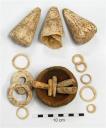 Excavators on Viti Levu, Fiji’s main island, found a cache of jewelry and high-quality pottery made by the Lapita people, the earliest settlers of Fiji. The artifacts are about 3,000 year old.
Excavators on Viti Levu, Fiji’s main island, found a cache of jewelry and high-quality pottery made by the Lapita people, the earliest settlers of Fiji. The artifacts are about 3,000 year old.
Fiji Museum staffer Sepeti Matararaba found the jewelry, made from shells, under an upturned clay pot, put there by someone about 3,000 years ago. When Matararaba turned the pot over, he uncovered a cache of nine shell rings of different sizes, four shell bracelets and six necklace pieces complete with drill holes. […]
The site was likely a manufacturing center for shell jewelry and the cache a “deliberate burial of a shell jewelry collection” by the Lapita inhabitants, Nunn said.
“These are the first people in the South Pacific, they are a Stone Age people,” he said. “Within a decade or so of arriving in Fiji they were producing exquisite shell jewelry … they were producing intricately decorated pottery.”
Not only is the ancient jump in artistic skill remarkable, but after the Lapita disappeared as a distinct group around 550 B.C., Fijians stopped producing that high quality of shell jewelry and pottery altogether.
Anthropology professor Peter Shepphard thinks the decorations were the Lapita’s attempt to stay connected to their roots in the Bismarck Archipelago. Perhaps once their identity as a people faded, so did their muse.






